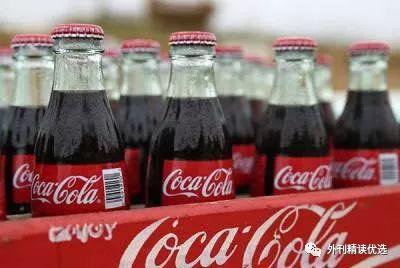来源 外刊精读优选
Theopposition by the New York State chapter of theN.A.A.C.P.to Mayor Michael R。 Bloomberg’s restrictions on sugary soda caught many Americans by surprise。 But it shouldn’t: though the organization argues it is standing up for consumer choice and minority business owners, who it claims would be hurt, this is also a favor for a stalwart ally — Coca-Cola alone has given generously to support N.A.A.C.P。 initiatives over the years。
美国全国有色人种协进会(NAACP)纽约州分会反对纽约市长迈克尔·R·布隆伯格(Michael R。 Bloomberg)限制含糖苏打饮料的举动让很多美国人颇感意外。但这不足为奇:尽管该组织称其维护的是消费者的选择权和少数族裔企业主的利益(该组织称这些人的利益会受损),他们也是在支持其忠实的盟友——可口可乐公司(Coca-Cola)多年来一直慷慨支持NAACP的活动。
This is more than a story of mutual back-scratching, though。 It is the latest episode in the long and often fractious history of soft drinks, prohibition laws and race。
但这不仅仅是一个相互利用的故事,还是软饮、禁令和种族三者之间经常矛盾的历史中的一个最新插曲。
While it is widely known that John Pemberton, an Atlanta pharmacist, invented Coke as a kind of patent medicine, it was in fact his second drink。 His first, an 1884 invention called French Wine Coca, was a copy of a popular French wine that contained cocaine。 But in November 1885, just as the product began to sell, Atlanta outlawed alcohol sales。
虽然很多人知道亚特兰大药剂师约翰·彭伯顿(John Pemberton)发明了可乐,最初是作为一种专利药品,但实际上可乐是他发明的第二种饮料,第一种饮料是他在1884年发明的法国葡萄酒可乐(French Wine Coca),那是一种颇受欢迎的法国葡萄酒的翻版,其中含有可卡因。然而,在1885年11月,当这种饮料开始有了销路时,亚特兰大颁布了禁酒令。
Across the nation, support for prohibition was often tied to the desire by native whites to control European Catholics, American Indians, Asian-Americans and, especially in the South, African-Americans。 It gave police officers an excuse to arrest African-Americans on the pretext of intoxication。
在全国范围内,支持禁酒令的通常是美国本土白人,他们希望借此控制来自欧洲的天主教徒移民、美国印第安人、亚裔美国人,以及非裔美国人,尤其是在南方,禁酒令让警方能够以醉酒为由逮捕非裔美国人。
Pemberton went to work on a “temperance drink” with the same “medicinal” effects, and he introduced Coca-Cola in 1886。 At the time, the soda fountains of Atlanta pharmacies had become fashionable gathering places for middle-class whites as an alternative to bars。 Mixed with soda water, the drink quickly caught on as an “intellectual beverage” among well-off whites。
于是彭伯顿开始致力于发明一种拥有同样“药效”的“无酒精饮料”,并在1886年推出了可口可乐。在当时,亚特兰大药店的冷饮柜台取代了酒吧,成为了中产阶级白人的时髦聚集场所。和苏打水混合在一起,这种饮料很快在富有白人中以“智力饮料”的名声流行起来。

Eliminating alcohol granted only a temporary reprieve。 Though Asa G。 Candler, who had taken over the business, kept the formula secret, an Atlanta paper revealed in 1891 what many consumers — who called the soda “dope” — already knew: Coca-Cola contained cocaine。
去掉酒精只能暂时地躲过禁令。尽管阿萨·G·坎德勒(Asa G。 Candler)接手药店生意后,一直将配方保密,但亚特兰大的一家报纸在1891年揭露了很多消费者已经知道的秘密:他们称饮料为苏打“麻醉剂”,因为可口可乐中含有可卡因。
Candler began marketing the drink as “refreshing” rather than medicinal, and managed to survive the controversy。 But concerns exploded again after the company pioneered its distinctive glass bottles in 1899, which moved Coke out of the segregated spaces of the soda fountain。 Anyone with a nickel, black or white, could now drink the cocaine-infused beverage。 Middle-class whites worried that soft drinks were contributing to what they saw as exploding cocaine use among African-Americans。 Southern newspapers reported that “negro cocaine fiends” were raping white women, the police powerless to stop them。 By 1903, Candler had bowed to white fears (and a wave of anti-narcotics legislation), removing the cocaine and adding more sugar and caffeine。
于是坎德勒开始宣传饮料的“提神功能”,而不是其药物功能,成功地避开了争议。但是,公司在1899年推出独特的玻璃瓶装可乐,再度引起关注,因为此举让饮料走出了药店冷饮柜台这个种族隔离的场所。不管是黑人、还是白人,只要手里有五分钱,就能喝上这种含有可卡因的饮料。中产阶级白人担心,软饮料正在进一步加剧在他们看来是非裔美国人大量使用可卡因的现象。南方报纸报道,“上了可卡因瘾的黑魔鬼”在强暴白人妇女,而警察却无力阻止他们。到了1903年,坎德勒不得不屈服于白人的恐惧(以及一股反麻醉剂的立法热潮),去除了饮料中的可卡因,添加了更多的糖和咖啡因。
Coke’s recipe wasn’t the only thing influenced by white supremacy: through the 1920s and ’30s, it studiously ignored the African-American market。 Promotional material appeared in segregated locations that served both races, but rarely in those that catered to African-Americans alone。
白人至上主义影响的不只是可乐的配方:从20世纪20年代到30年代,可乐的营销策略一直刻意忽略非洲裔美国人市场。可乐的宣传品会出现在隔离白人和黑人的两个种族都能去的服务场所,但很少会出现在只为美国黑人提供服务的地方。
Meanwhile Pepsi, the country’s second largest soft drink company, had tried to fight Coke by selling its sweeter product in a larger bottle for the same price。 Still behind in 1940, Pepsi’s liberal chief executive, Walter S。 Mack, tried a new approach: he hired a team of 12 African-American men to create a “negro markets” department。
与此同时,美国第二大软饮料商百事(Pepsi)努力与可乐竞争,它用更大的瓶子装其更甜的饮料,但售价却与可乐一样。百事公司在1940年销售量仍落后于可口可乐公司,因此百事的自由派首席执行官沃尔特·S·麦克(Walter S。 Mack)尝试了一种新方法:他招聘了12位非洲裔美国男子,组建了“黑人市场”部。
By the late 1940s, black sales representatives worked the Southern Black Belt and Northern black urban areas, black fashion models appeared in Pepsi ads in black publications, and special point-of-purchase displays appeared in stores patronized by African-Americans。 The company hired Duke Ellington as a spokesman。 Some employees even circulated racist public statements by Robert W。 Woodruff, Coke’s president。
到20世纪40年代后期,黑人销售代表在南方的黑人居住带和北方的黑人都市区中作推销,黑人时装模特开始出现在黑人出版物中刊登的百事广告上,为销售点特制的商品展示也开始出现在非洲裔美国人光顾的商店里。百事公司雇了爱灵顿公爵(Duke Ellington)担任其形象代言人。一些员工甚至散布可口可乐公司总裁罗伯特·W·伍德拉夫(Robert W。 Woodruff)公开发表的的种族歧视言论。
The campaign was so successful that many Americans began using a racial epithet to describe Pepsi。 By 1950, fearing a backlash by white consumers, Pepsi had killed the program, but the image of Coke and Pepsi as “white” and “black” drinks lingered。
百事的营销活动相当成功,以至于一些美国人开始用一个带有种族歧视意味的说法来描述百事。到了1950年,由于担心引起白人消费者的抵制,百事公司停止了专门针对黑人的营销方案,但可乐和百事分别作为“白人饮料”和“黑人饮料”的形象继续存在。

Not long after, perhaps seeing the business error of its ways, Coke quietly began to market to African-Americans。 Eventually, part of Coke’s strategy was to support African-American organizations, forming the basis of its relationship with the N.A.A.C.P。
那以后不久,可口可乐公司可能意识到其商业错误,于是悄悄地开始向非洲裔美国人发起营销。可口可乐公司的策略之一就是支持非裔美国人的组织,从而最终为该公司和NAACP之间的关系奠定了基础。
The historical weight of that relationship came to the surface after a 1999 discrimination case brought by black Coke employees, which created bad press for the company around the world。 In 2000, Coke agreed to a settlement for $156 million and made a $50 million donation to the Coca-Cola Foundation to support community programs。
1999年,由可口可乐公司黑人员工提起的种族歧诉讼案,给该公司带来了全球性的负面报道,在那之后,公司和NAACP之间关系的历史担当也浮出水面。2000年,可口可乐公司同意支付1.56亿美元的和解费用,并向可口可乐基金会(Coca-Cola Foundation)捐赠了5000万美元,以支持社区项目。
译自 纽约时报





举报成功